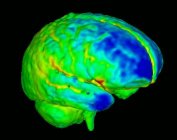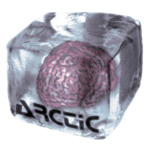DBP2:UNCFinal:2010
From NAMIC Wiki
Revision as of 13:10, 1 February 2011 by Medcomparts (talk | contribs)
Home < DBP2:UNCFinal:2010
back to DBP2 Main
Overview
The analysis of neuroimaging data from pediatric populations presents several challenges. There are normal variations in brain shape from infancy to adulthood and normal developmental changes related to tissue maturation. Measurement of cortical thickness is one important way to analyze these developmental tissue changes. As a DBP, our group is interested in the longitudinal study of early brain development by measuring cortical thickness in autistic children and controls.
- We first developed a novel framework to perform individual regional cortical thickness analysis [3, 4]. This framework entails first an atlas-based automatic tissue segmentation via an expectation maximization scheme in order to compute probabilistic and hard tissue segmentations. Secondly, the skull is stripped using a post-processed hard tissue segmentation label map as a mask. Thirdly, a B-spline registration, initialized by centers of mass, rigid then affine registration, is computed to register a T1-weighted atlas to the corrected T1w skull-stripped image. A multi-threaded coarse-to-fine registration scheme using mattes mutual information metric is considered. The full transformation is then applied to a lobar parcellation map defined in the atlas space, dividing the brain into 20+ lobes. Using both the tissue segmentation label map and the registered parcellation map, sparse and asymmetric cortical thickness measurements are finally computed for each lobe.
- This framework has been incorporated in our ARCTIC tool, an open source C++ based high-level module disseminated as part of the 3D Slicer toolkit. ARCTIC’s setup allows for efficient batch processing and grid computing via BatchMake (Kitware Inc).
- We performed a longitudinal MRI study investigating early growth trajectories in brain volume and cortical thickness. Cerebral gray and white matter volumes and cortical thickness in children with autism spectrum disorder and controls were examined. Subjects were seen at approximately 2 years of age (autism = 59, controls = 38) and were rescanned approximately 24 months later at age 4-5 years (autism = 38, controls = 21). Results and conclusions should be published soon (paper submitted to AGP, Archives of General Psychiatry).
- We also developed a novel framework that allows group-wise automatic mesh-based analysis of cortical thickness [1, 2, 5, 6]. Our analysis framework consists of a pipeline of C++ based automated 3D Slicer compatible modules. The approach is divided into four parts. First an individual pre-processing pipeline is applied on each subject to create genus-zero inflated white matter cortical surfaces with cortical thickness measurements. The second part performs an entropy-based group-wise shape correspondence on these meshes using a particle system, which establishes a trade-off between an even sampling of the cortical surfaces and the similarity of corresponding points across the population using sulcal depth information and spatial proximity. A novel automatic initial particle sampling is performed using a matched 98-lobe parcellation map prior to a particle-splitting phase. Third, corresponding re-sampled surfaces are computed with interpolated cortical thickness measurements, which are finally analyzed via a statistical vertex-wise analysis module.
- This framework has been tested on a small pediatric dataset and incorporated in an open source C++ based high-level module called GAMBIT. GAMBIT’s setup allows efficient batch processing, grid computing and quality control.
Software
- ARCTIC (Automatic Regional Cortical ThICkness)
- Description:
- ARCTIC is an end-to-end application allowing individual lobar analysis of cortical thickness
- Pipeline: tissue segmentation, regional atlas deformable registration, cortical thickness measurements, volume information stored in spreadsheets
- Visualization: white matter and gray matter mesh creation
- Quality control: optimal QC via 3D Slicer MRML scenes
- Download:
- Source code, executables and tutorial are available on NITRC
- Latest stable version is directly available as an extension in Slicer 3.6.1 release and soon in Slicer 3.6.2
- Documentation:
- Tutorials:
- Description:
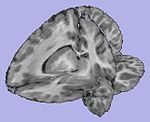
|
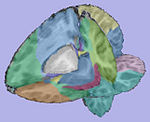
|
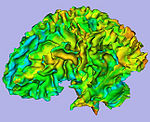
|

|
| T1-weighted skull-stripped image | Parcellation image | Cortical thickness on WM surface | Cortical thickness information |
- GAMBIT (Group-wise Automatic Mesh Based analysis of cortIcal Thickness)
- Description:
- GAMBIT is an end-to-end application allowing allowing group-wise automatic mesh-based analysis of cortical thickness as well as other surface area measurements
- Pipeline: individual preprocessing pipeline, group-wise particle-based correspondence on inflated genus-zero white matter surfaces, group-wise statistical analysis
- Visualization: inflated and folded white matter surfaces in correspondence, with cortical thickness and sulcal depth as overlays
- Quality control: optimal QC via 3D Slicer MRML scenes
- Download:
- Source code, executables and tutorial are available on NITRC
- Latest stable version is available soon as an extension in Slicer 3.6.2
- Documentation:
- Tutorials:
- Description:

|

|
| Cortical thickness overlayed on inflated cortical surfaces | Sucal depth overlayed on inflated cortical surfaces |
Listing and short description of the sample data
- Pediatric Brain MRI data available on MIDAS
- Data of 2 autistic children and 2 normal controls (male, female) scanned at 2 years with follow up at 4 years from a 1.5T Siemens scanner. Files include structural data, tissue segmentation label map and subcortical structures segmentation.
- Brain Atlases available on MIDAS
- Average T1-weighted images (with/without skull) are provided with tissue segmentation probability maps (white matter, gray matter, csf, rest), subcortical structures probability maps (amygdala, caudate, hippocampus, pallidus, putamen) and lobar parcellation maps
- Pediatric atlas
- Adult atlas
- Elderly atlas
- Primate atlas
- Tutorial datasets:
Related pages
- Slicer 3.6 download
- Slicer 3.6 documentation
- Neuro Image Research and Analysis Laboratory, UNC Chapel Hill
- UNC Carolina Institute for Developmental Disabilities
References
- C. Vachet, H.C. Hazlett, M. Niethammer, I. Oguz, J.Cates, R. Whitaker, J. Piven, M. Styner, Group-wise Automatic Mesh-Based Analysis of Cortical Thickness, accepted to SPIE 2011
- Oguz I., Niethammer M., Cates J., Whitaker R., Fletcher T., Vachet C., Styner M. Cortical Correspondence with Probabilistic Fiber Connectivity. Inf Process Med Imaging. 2009;21:651-63. PMID: 19694301. PMCID: PMC2751643.
- H.C. Hazlett, C. Vachet, C. Mathieu, M. Styner, J. Piven, Use of the Slicer3 Toolkit to Produce Regional Cortical Thickness Measurement of Pediatric MRI Data, presented at the 8th Annual International Meeting for Autism Research (IMFAR) Chicago, IL 2009.
- C. Mathieu, C. Vachet, H.C. Hazlett, G. Geric, J. Piven, and M. Styner, ARCTIC – Automatic Regional Cortical ThICkness Tool, UNC Radiology Research Day 2009 abstract.
- Oguz, I., Cates, J., Fletcher, T., Whitaker, R., Cool, D., Aylward, S., Styner, M., Cortical correspondence using entropy-based particle systems and local features, IEEE Symposium on Biomedical Imaging ISBI 2008. 1637-1640.
- J. Cates J., Fletcher P.T., Styner M., Hazlett H.C., Whitaker R. Particle-Based Shape Analysis of Multi-object Complexes. Int Conf Med Image Comput Comput Assist Interv. 2008;11(Pt 1):477-485. PMID: 18979781. PMCID: PMC2753605.
